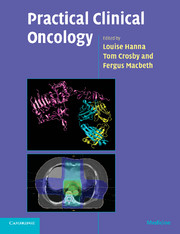Book contents
- Frontmatter
- Contents
- List of contributors
- Preface
- Acknowledgements
- Abbreviations
- 1 Practical issues in cytotoxic chemotherapy usage
- 2 Biological treatments in cancer
- 3 Hormones in cancer
- 4 Radiotherapy planning
- 5 Research in cancer
- 6 Oncological emergencies
- 7 Palliative care
- 8 Head and neck
- 9 Oesophagus
- 10 Stomach
- 11 Liver, gallbladder and biliary tract
- 12 Exocrine pancreas
- 13 Colon and rectum
- 14 Anus
- 15 Gastrointestinal stromal tumours
- 16 Breast
- 17 Kidney
- 18 Bladder
- 19 Prostate
- 20 Testis
- 21 Penis
- 22 Ovary
- 23 Body of the uterus
- 24 Cervix
- 25 Vagina
- 26 Vulva
- 27 Gestational trophoblast tumours
- 28 Lung
- 29 Mesothelioma
- 30 Soft tissue and bone tumours in adults
- 31 The lymphomas and myeloma
- 32 Central nervous system
- 33 Skin cancer other than melanoma
- 34 Melanoma
- 35 Thyroid
- 36 Neuroendocrine tumours
- 37 Cancer in children
- 38 Cancer of unknown primary
- 39 The use of radiotherapy in the treatment of benign conditions
- Multiple choice questions
- Multiple choice answers
- Index
- References
1 - Practical issues in cytotoxic chemotherapy usage
Published online by Cambridge University Press: 23 December 2009
- Frontmatter
- Contents
- List of contributors
- Preface
- Acknowledgements
- Abbreviations
- 1 Practical issues in cytotoxic chemotherapy usage
- 2 Biological treatments in cancer
- 3 Hormones in cancer
- 4 Radiotherapy planning
- 5 Research in cancer
- 6 Oncological emergencies
- 7 Palliative care
- 8 Head and neck
- 9 Oesophagus
- 10 Stomach
- 11 Liver, gallbladder and biliary tract
- 12 Exocrine pancreas
- 13 Colon and rectum
- 14 Anus
- 15 Gastrointestinal stromal tumours
- 16 Breast
- 17 Kidney
- 18 Bladder
- 19 Prostate
- 20 Testis
- 21 Penis
- 22 Ovary
- 23 Body of the uterus
- 24 Cervix
- 25 Vagina
- 26 Vulva
- 27 Gestational trophoblast tumours
- 28 Lung
- 29 Mesothelioma
- 30 Soft tissue and bone tumours in adults
- 31 The lymphomas and myeloma
- 32 Central nervous system
- 33 Skin cancer other than melanoma
- 34 Melanoma
- 35 Thyroid
- 36 Neuroendocrine tumours
- 37 Cancer in children
- 38 Cancer of unknown primary
- 39 The use of radiotherapy in the treatment of benign conditions
- Multiple choice questions
- Multiple choice answers
- Index
- References
Summary
Introduction
In this chapter, the principles of cytotoxic chemotherapy treatment and the appropriate use of anticancer drugs, including some of the new targeted drugs, will be discussed. It will not be possible to give a comprehensive description of every drug and regimen, and standard chemotherapy textbooks (e.g. Allwood et al., 2002; Summerhays and Daniels, 2003) or specialist websites (e.g. BC Cancer Agency, www.bccancer.bc.ca/default.htm) should be consulted for this information. However, this chapter should provide chemotherapy prescribers and administrators with enough information to discuss treatments with patients, to prescribe chemotherapy safely and to manage the common treatment-related side effects.
Aims of chemotherapy treatment
There are three main indications for the use of chemotherapy:
The management of patients with curable advanced malignancies including choriocarcinoma, testicular cancer, Hodgkin lymphoma and high-grade non-Hodgkin lymphoma (NHL).
The preoperative or postoperative adjuvant treatment of localised malignancies, primarily breast cancer and colorectal cancer.
The treatment of patients with advanced incurable malignancies, where the primary aim is palliation and symptom control, sometimes without a major expectation of prolonging survival.
Before starting a course of chemotherapy, both the prescriber and the patient should be clear about the aims of treatment. When chemotherapy is used curatively, it is essential to maintain the calculated dose and dosage schedule according to the treatment protocol.
- Type
- Chapter
- Information
- Practical Clinical Oncology , pp. 1 - 12Publisher: Cambridge University PressPrint publication year: 2008

